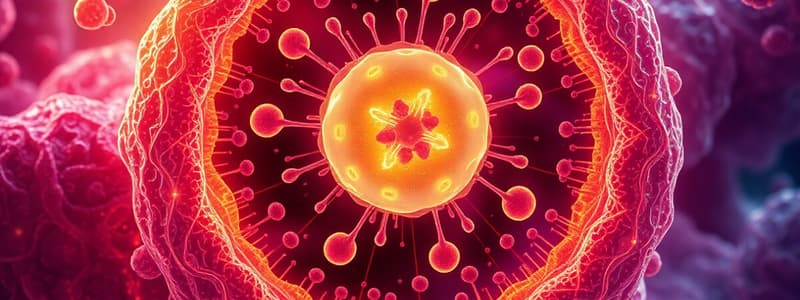Podcast
Questions and Answers
What is a primary characteristic that distinguishes prokaryotic and eukaryotic cells?
What is a primary characteristic that distinguishes prokaryotic and eukaryotic cells?
- Type of cytoplasm
- Size of ribosomes
- Presence or absence of a nucleus (correct)
- Presence or absence of a cell wall
How do prokaryotes primarily reproduce?
How do prokaryotes primarily reproduce?
- Binary fission (correct)
- Fragmentation
- Meiosis
- Mitosis
Which statement accurately describes the genetic material of prokaryotes?
Which statement accurately describes the genetic material of prokaryotes?
- It is linear and contained within a nucleus.
- It is identical to the genetic material of eukaryotes.
- It is circular and located in the cytoplasm. (correct)
- It consists of multiple chromosomes.
How do prokaryotes contribute to genetic diversity?
How do prokaryotes contribute to genetic diversity?
Which of the following is accurate about prokaryotic domains?
Which of the following is accurate about prokaryotic domains?
Which cellular component is responsible for the synthesis of proteins in both prokaryotic and eukaryotic cells?
Which cellular component is responsible for the synthesis of proteins in both prokaryotic and eukaryotic cells?
What distinguishes prokaryotic cells from eukaryotic cells with respect to genetic material?
What distinguishes prokaryotic cells from eukaryotic cells with respect to genetic material?
What role does the cell membrane play in maintaining cell homeostasis?
What role does the cell membrane play in maintaining cell homeostasis?
How do prokaryotic and eukaryotic ribosomes differ?
How do prokaryotic and eukaryotic ribosomes differ?
Which organelle is responsible for energy production through cellular respiration in eukaryotes?
Which organelle is responsible for energy production through cellular respiration in eukaryotes?
Which cellular structure aids some prokaryotes in movement using a whip-like motion?
Which cellular structure aids some prokaryotes in movement using a whip-like motion?
What is the main function of the lysosomes within a eukaryotic cell?
What is the main function of the lysosomes within a eukaryotic cell?
What is the function of the capsule found in some prokaryotic cells?
What is the function of the capsule found in some prokaryotic cells?
Flashcards
Prokaryotic Cells
Prokaryotic Cells
Cells without a nucleus and membrane-bound organelles.
Eukaryotic Cells
Eukaryotic Cells
Cells that have a nucleus and membrane-bound organelles.
Reproduction Methods
Reproduction Methods
Prokaryotes reproduce asexually; eukaryotes reproduce both sexually and asexually.
Genetic Material in Prokaryotes
Genetic Material in Prokaryotes
Signup and view all the flashcards
Domains of Life
Domains of Life
Signup and view all the flashcards
Nucleus
Nucleus
Signup and view all the flashcards
Ribosomes
Ribosomes
Signup and view all the flashcards
Cell Wall
Cell Wall
Signup and view all the flashcards
Mitochondria
Mitochondria
Signup and view all the flashcards
Endoplasmic Reticulum (ER)
Endoplasmic Reticulum (ER)
Signup and view all the flashcards
Capsule
Capsule
Signup and view all the flashcards
Study Notes
Cellular Structure Differences
- Prokaryotic cells lack a nucleus and other membrane-bound organelles. Eukaryotic cells possess a nucleus and various membrane-bound organelles.
- Prokaryotic cells are generally smaller and simpler in structure than eukaryotic cells.
- The genetic material (DNA) in prokaryotic cells is circular and located in the cytoplasm, a region called the nucleoid. Eukaryotic DNA is linear and contained within the nucleus.
Prokaryotic Cell Structure
- Cell wall: Provides structural support and protection. Composed of peptidoglycan in bacteria, but different in archaea.
- Cell membrane: Regulates the passage of substances into and out of the cell, crucial for homeostasis.
- Cytoplasm: The jelly-like substance filling the cell, containing ribosomes and other essential components.
- Ribosomes: Involved in protein synthesis. Prokaryotic ribosomes are smaller than eukaryotic ribosomes.
- Capsule (some prokaryotes): A protective layer outside the cell wall, aiding in attachment and preventing desiccation.
- Flagella (some prokaryotes): Long, whip-like appendages that aid in movement.
- Pili (some prokaryotes): Hair-like appendages that facilitate attachment to surfaces or other cells.
Eukaryotic Cell Structure
- Nucleus: Contains the cell's genetic material (DNA) and controls cellular functions.
- Endoplasmic Reticulum (ER): A network of membranes involved in protein and lipid synthesis.
- Golgi apparatus: Processes, sorts, and packages proteins and lipids for secretion or use within the cell.
- Mitochondria: The "powerhouses" of the cell, responsible for cellular respiration and ATP production.
- Lysosomes: Contain digestive enzymes to break down waste materials and cellular debris.
- Vacuoles: Storage sacs for water, nutrients, or waste products. Plant cells often have a large central vacuole.
- Cytoskeleton: A network of protein fibers providing structural support, facilitating cell movement, and intracellular transport.
Ribosomes in both types
- Ribosomes are present in both prokaryotic and eukaryotic cells, crucial for protein synthesis.
Key Differences Summarized
| Feature | Prokaryotic | Eukaryotic |
|---|---|---|
| Nucleus | Absent | Present |
| Organelles | Absent (membrane-bound) | Present (membrane-bound) |
| DNA | Circular | Linear |
| Size | Smaller | Larger |
| Complexity | Simpler | More complex |
Reproduction
- Prokaryotes primarily reproduce asexually through binary fission.
- Eukaryotes reproduce both sexually and asexually.
Metabolic Diversity
- Prokaryotes exhibit remarkable metabolic diversity, playing crucial roles in nutrient cycling and decomposition.
- Eukaryotic metabolisms are more complex, supporting a wide range of functions.
Genetic Recombination in Prokaryotes
- Prokaryotes can exchange genetic material through processes like conjugation, transformation, and transduction. This contributes to genetic diversity.
Domains
- Prokaryotic organisms are classified into two domains: Bacteria and Archaea.
- Eukaryotic organisms are part of the domain Eukarya.
Importance of Prokaryotes
- Prokaryotes are essential for ecosystem function and have various applications in biotechnology.
Differences in Genetic Material Expression
- Control mechanisms for gene expression are more complex in eukaryotes compared to prokaryotes, leading to greater regulation of protein production.
Studying That Suits You
Use AI to generate personalized quizzes and flashcards to suit your learning preferences.




